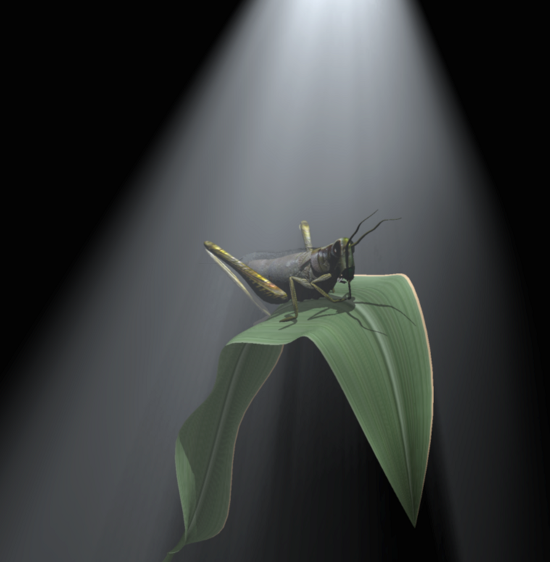You can create volumic lights using volume shaders, but a simpler method is to apply a volumic property to your light. The volumic property is also applied at the scene level and it can be easily activated to create simple scene atmospherics (as described in Creating Depth Fading with a Volumic Property).

This scene uses a single volumic spotlight with Shards. The Force Volumic Shadows parameter is on, thereby making the leaf block some of the volumic light.
Select an existing light or create a new one (Get  Primitive
Primitive  light).
light).
Make sure the light shader (soft_light by default) has Light Attenuation  Light Falloff enabled.
Light Falloff enabled.
From the Render toolbar, choose Get  Property
Property  Volumic. The Volumic Light Property Editor opens.
Volumic. The Volumic Light Property Editor opens.
On the Volumic tab, the principle parameter to edit when defining a volumic light is Map Size, which determines the depth map resolution of the effect.
If the objects the volumic light is crossing are simple, the map volume can be set very low (100 to 200). But if the objects in the light's path are complex, such as very sharp edges, you need to increase the Map Size value to pick up more of the object's shape detail, creating a better volumic effect. Note that increasing the Map Size value slows rendering.
Adjust the Reflectance parameter to simulate the volume's reflectivity. A low value (0.5) simulates a volumic effect with low reflectivity, such as dust. A higher value (greater than 2) creates a reflective volume, such as dense smoke.
You can set the distance from the light source at which the volumic effect begins by using the Min Distance slider.
Select Force Volume Shadows to force the rendering of shadows for the volumic effect.
To make the volumic effect have a transparent quality, select Transparent.
On the Shards tab, set the volumic light's shard parameters. They are off by default. You can activate shards, set their intensity, complexity, and resolution.
Depth fading, sometimes called fog or atmospherics, adds an element of realism to a scene by creating a sense of depth by adding a layer of ambient-like color (usually black or gray) in relation to an object's distance from the camera. There are two basic ways to create depth fading in a scene: by applying a volumic light property or by applying a volume shader.
Below, the scene is without depth fading (top image), and with a depth fading effect (bottom image). The fade color is set to black with no transparency. Notice how the spheres appear to be less visible over distance.
From the Render toolbar, choose Get  Property
Property  Volumic. This applies a volumic property to the selected light as well as to the scene.
Volumic. This applies a volumic property to the selected light as well as to the scene.
In the explorer, set its scope to Scene Root and click the Volumic Properties icon (below the Scene_Root) to open the Volumic Scene Property Editor.
On the Depth Fading tab, select the Enabled checkbox to activate the depth fading effect and define the Start and End Distance, the Transparency, and the fade color.
 Except where otherwise noted, this work is licensed under a Creative Commons Attribution-NonCommercial-ShareAlike 3.0 Unported License
Except where otherwise noted, this work is licensed under a Creative Commons Attribution-NonCommercial-ShareAlike 3.0 Unported License